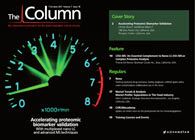Healthy spaghetti
The health benefits of barley grain as a source of dietary fibre are well known. In the case of barley, as with most cereals, the phenolic compounds are concentrated in the bran, which until recently was removed during the milling process. Now food researchers are investigating the possibility of producing barley flours naturally enriched in bioactive compounds and have shown that the separation of different fractions of whole barley by pearling have resulted in the outermost fractions yielding the highest phenolic content.

The health benefits of barley grain as a source of dietary fibre are well known. In the case of barley, as with most cereals, the phenolic compounds are concentrated in the bran, which until recently was removed during the milling process. Now food researchers are investigating the possibility of producing barley flours naturally enriched in bioactive compounds and have shown that the separation of different fractions of whole barley by pearling have resulted in the outermost fractions yielding the highest phenolic content. These fractions are suitable for use in many different kinds of food including bread and pasta.
In this research, barley byproducts were obtained by air classification to produce a different barley functional spaghetti, which was compared with a variety of commercial whole semolina samples.1 Capillary electrophoresis was used to determine the phenolic compounds. The barley spaghetti showed the highest content of dietary fibre. Commercial samples reported a content of ß-glucans lower than 0.6% dm, while barley spaghetti showed a content of 5.2, 4.9 and 10.2% dm in the three samples investigated. These contents meet the FDA requirements of 0.75 g of ß-glucans per serving, which would allow the spaghetti to merit the health claim of a good source of dietary fibre that may reduce the risk of heart disease.
1. Vito Verardo et al., Journal of Agricultural and Food Chemistry, 59(17), 9127–9134 (2011).
This story originally appeared in The Column. Click here to view that issue.
New TRC Facility Accelerates Innovation and Delivery
April 25th 2025We’ve expanded our capabilities with a state-of-the-art, 200,000 sq ft TRC facility in Toronto, completed in 2024 and staffed by over 100 PhD- and MSc-level scientists. This investment enables the development of more innovative compounds, a broader catalogue and custom offering, and streamlined operations for faster delivery. • Our extensive range of over 100,000 high-quality research chemicals—including APIs, metabolites, and impurities in both native and stable isotope-labelled forms—provides essential tools for uncovering molecular disease mechanisms and exploring new opportunities for therapeutic intervention.
New Guide: Characterising Impurity Standards – What Defines “Good Enough?”
April 25th 2025Impurity reference standards (IRSs) are essential for accurately identifying and quantifying impurities in pharmaceutical development and manufacturing. Yet, with limited regulatory guidance on how much characterisation is truly required for different applications, selecting the right standard can be challenging. To help, LGC has developed a new interactive multimedia guide, packed with expert insights to support your decision-making and give you greater confidence when choosing the right IRS for your specific needs.

.png&w=3840&q=75)

.png&w=3840&q=75)



.png&w=3840&q=75)



.png&w=3840&q=75)











